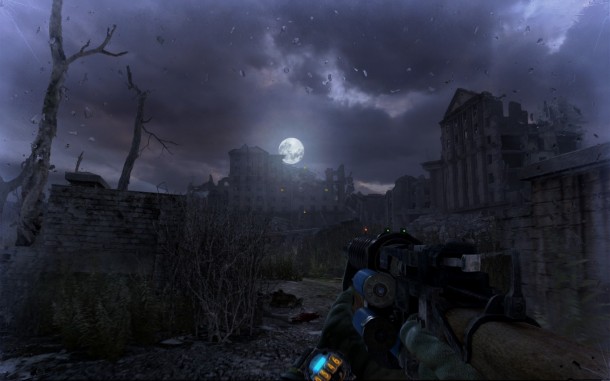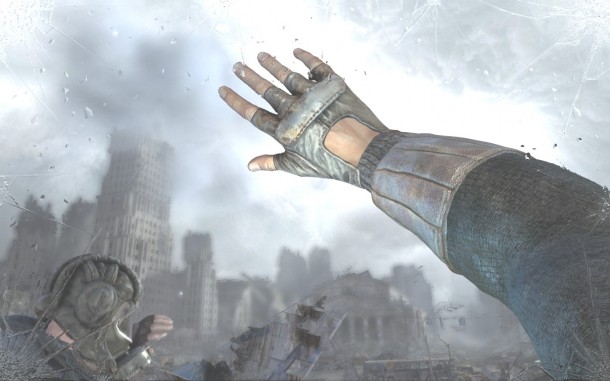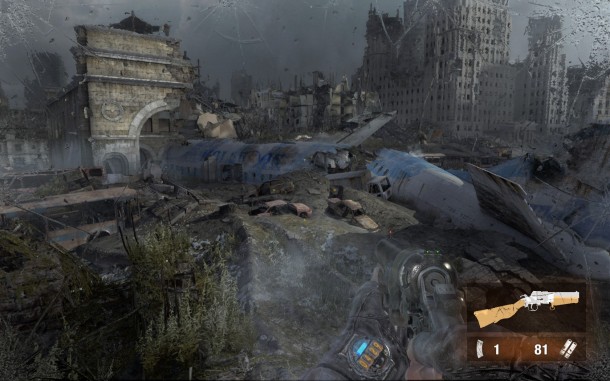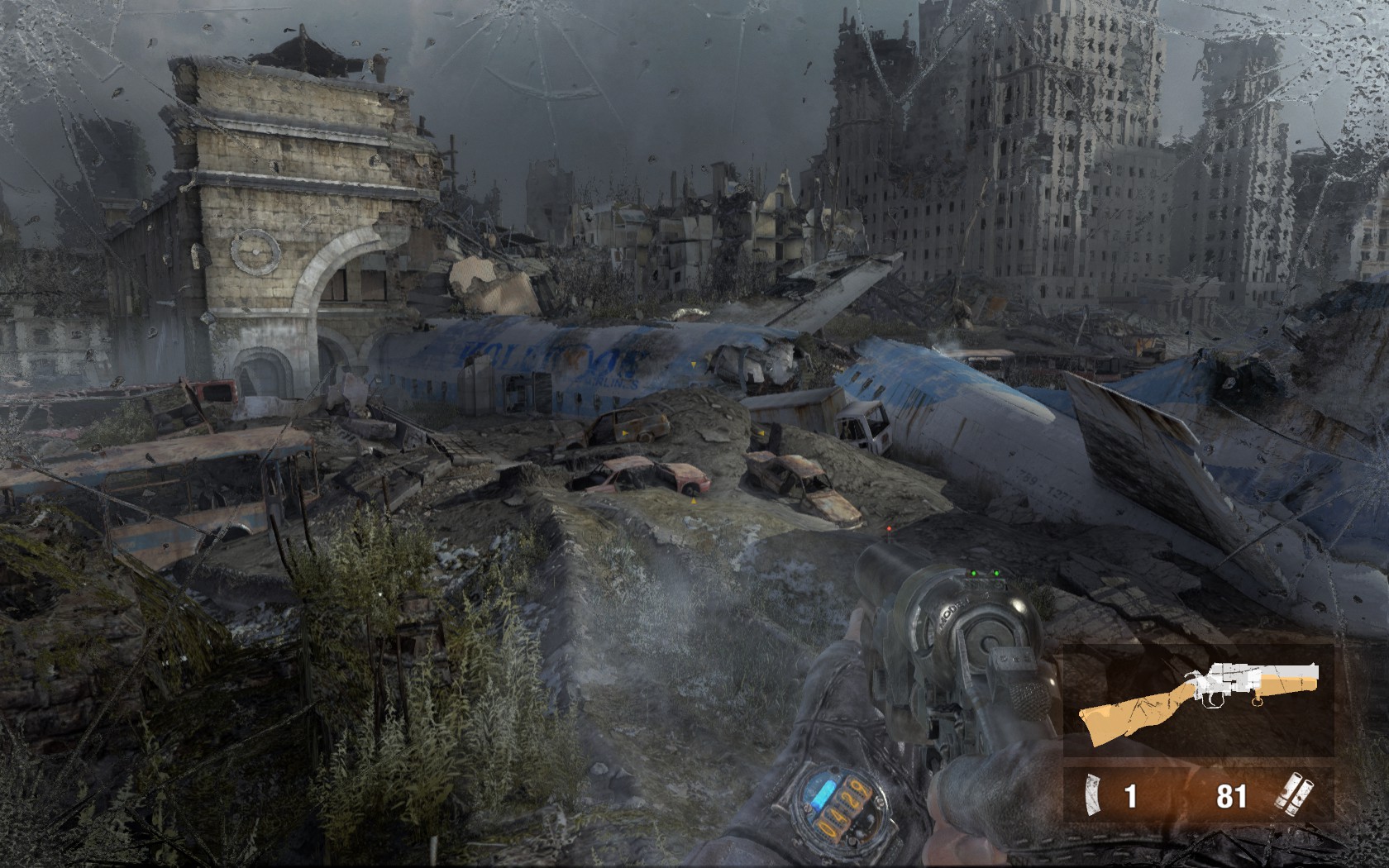Metro: Last Light is not a perfect videogame. It can be clunky, it can be slow moving, and at some points, it can be flat out dumb. Sometimes, though, you don’t care about perfection. Chasing after a singular goal with a lot of heart can be enough, and Metro has heart in spades.
Metro: Last Light explains everything that would be HUD items in other games, in a contextual, in-world way. You navigate with your compass (which is attached to a clip board that has your objective written on it), your watch has the air filter countdown as well as a light on it indicating your visibility, and you can see how much ammo is in your guns by looking. All of these things are in service of keeping you inside of the game, and they work extremely well.
This effort to keep you in the world extended to the entirety of the metro system, itself. Every man, woman, and child feels like they have a place in this post-nuclear event society. Each metro station is its own village, with its own culture. Everything from the military complexes, to the whore houses (more on this later) felt like they had a place in this world.
If the same amount of care that was put into the world was put into the story and plot, then maybe I would have felt a bit better about it. Metro: Last Light’s story isn’t bad, but it feels like a waste. The basic plot revolves around Antyom, the hero of Metro 2033, following other people around the metro system, letting them tell him what to do for no real reason. Of course, Antyom has a terrible case of silent protagonist, so he can’t argue with anyone or tell any of the other characters to screw themselves. Seriously, it’s 2013. Silent protagonists need to go the way of the dodo.

From one macguffin to another, you trudge Antyom through this beautiful, bleak world. Constantly helping others who only promise to be looking out for your best interests. All of this culminates with one of the most abrupt endings to a storyline (actually, two storylines) that I have ever seen in any form of media. The story goes from rising action, to climax, to falling action in a space of ten minutes. And none of it is very satisfying.
If the story does nothing other than bring you through the terrifying world, it would be enough. However, the combat in Metro: Last Light is simply fantastic. In Metro 2033, none of the weapons felt satisfying – some argued that was the point, I disagree – but this time around, every gun has its place. I spent the majority of the game running around with a silenced pistol, a high-powered shotgun, and a machine gun. Each of which had their own specific uses.
The pistol spent the most time equipped, even though it was probably my least used gun. In any encounter with human enemies, I stealthed around the areas killing as many soldiers with my knife (no longer a selectable weapon, used by pressing in the right stick). Stealth is very gratifying and much easier in Last Light because of your aforementioned watch indicator, as well as very helpful audio stingers that hit when an enemy might see you.

On the other end of the spectrum was the creature enemies, and the bosses. All of which have one attack: Charging. Not only is it boring to shoot at enemies that only run straight at you, but if they do close the distance, you have no way to easily dodge out of the way. Fighting the various creatures is also when the difficulty has a tendency to spike. This usually happens when you are tasked with holding off a group of enemies while waiting for a vehicle of some kind to come pick you up.
Last Light doesn’t seem to know what it wants to do in the way of its women in the world. At one point, you have to follow a strong woman, but later on, you bed down with that same woman for what seems to be no other reason than to see her boobs. The strip clubs and whore houses feel believable in a world like this, but at the same time, would my character really sit down and waste his ammo just to see breasts that have antigravity capabilities that rival that of Dead or Alive? It all feels very tenuous, and the extent to which the naked female form is shown feels very unnecessary.
If Metro 2033 was too much for you to get into, I still recommend checking out Last Light. It feels much more accessible. On normal difficulty, there is much more ammo to be had and enemies go down in a believable number of shots. Even the PC requirements have loosened. My machine has a couple-year-old video card (everything else is pretty new), and I was able to run the game on “Very High” settings at a high framerate. This definitely isn’t a netbook game, but even lower-end computers will have no problems running this game on lower settings.

Something worth mentioning for Metro 2033 veterans is that Ranger Mode is not included with the standard purchase of Metro: Last Light. For a game that is all about immersion, the mode that allows for more realism (no HUD, less ammo, accurate bullet damage) being held off for an extra $5 DLC is a little bit crazy. Hell, on the game’s website, it is stated that Ranger Mode is “The way [the game] was meant to be played. So know going in that you will have to spend extra money just to get the full version of the game.
Metro: Last Light is a game that is greater than the sum of its parts. The combat and the environment go a long way to cover up a lackluster story, and some questionable portrayals of the women in the world. The world of Metro: Last Light is one that should be viewed by as many people as possible, as it truly is a beautifully tragic place.
This review is based on the final code of the PC version of Metro: Last Light, provided by publisher Deep Silver.


No Comments